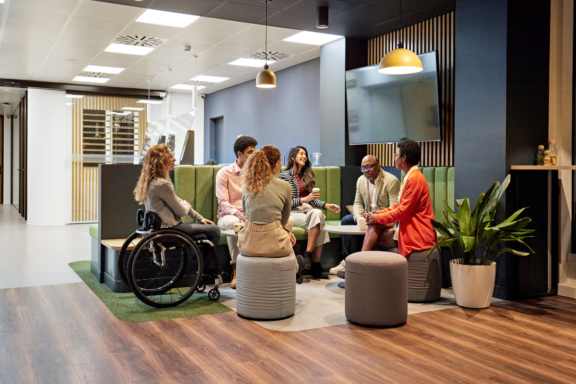The average person spends a third of their life at work, and the environment in which they work can make or break their future with the organization. Keeping employees happy boosts retention and improves business performance. In fact, Deloitte research shows 94% of executives and 88% of employees say a distinct workplace culture is key to business success.
But what type of work environment best suits your industry and employees? And how do you cultivate a positive culture? The following guide outlines different types of work environments, what industries they suit, and how to best cultivate each environment.
Main Elements of Work Environments
A work environment encompasses all the physical, psychological, social, and cultural elements that shape an employee’s experience within an organization. It includes everything from the physical workspace and technology to management styles, company policies, interpersonal relationships, and organizational values.
Types of Work Environments

The most common types of work environments include the following:
1. Conventional Work Environment
A conventional work environment is what most consider the traditional workplace. It includes set hours, clear delineation of job roles, designated work stations, and a hierarchical structure. Unlike many work environments, which are becoming more flexible and employing hybrid models, the conventional employer prefers an in-person work setting. These environments are rooted in structure, consistency, and methodical approaches to work that facilitate reliable service delivery and operational stability.
The conventional environment creates a framework where expectations are crystal clear and advancement pathways are well-defined. Employees know precisely what success looks like and can chart a predictable career trajectory by meeting established performance metrics. This clarity reduces workplace anxiety for many professionals who prefer knowing exactly where they stand and what’s expected of them.
Individuals who prefer logical, systematic thinking thrive best in this work environment type. That’s why it’s suited to the following industries:
- Banking and financial services
- Healthcare administration
- Legal services
2. Creative Work Environment
While the conventional work environment uses chain of command, creative environments offer more of an open-door policy where new ideas and taking risks are encouraged. Visually, these spaces often feature unconventional design elements, varied work areas, and amenities that spark inspiration.
Unlike more structured environments, creative workplaces emphasize outcomes over processes, giving employees significant autonomy in how they approach their work. Collaboration often happens organically, and experimentation is not only allowed, but valued. Flexibility is a hallmark—both in terms of scheduling and role definitions—which enables spontaneous innovation and cross-functional teamwork.
Feedback tends to be informal and continuous, supporting rapid iteration and agile thinking. This environment suits individuals who draw energy from brainstorming sessions, visual thinking, and conceptual problem-solving. Examples of creative work environment industries include:
- Advertising and marketing
- Entertainment and media production
- Architecture and interior design
3. Collaborative Work Environment
A collaborative work environment prioritizes teamwork, shared responsibility, and collective problem-solving. It features open workspaces, frequent team meetings, and technologies that facilitate group communication. These spaces are designed to break down silos between departments and encourage cross-functional partnerships that drive innovation and comprehensive solutions to complex challenges.
The collaborative environment fosters psychological safety where team members feel comfortable sharing ideas without fear of criticism. This safety net creates the conditions necessary for creative risk-taking and honest feedback that elevates the quality of work. By valuing diverse perspectives, these environments tap into the collective intelligence of the entire organization rather than relying on isolated individual contributions.
Professionals who energize through social interaction and enjoy building on others’ ideas flourish in collaborative settings. This approach particularly benefits these industries:
- Design and creative agencies
- Research and development
- Software development
4. Remote Work Environment
A remote work environment operates without centralized physical workspaces, relying instead on digital infrastructure to connect distributed team members. These settings feature robust communication technologies, cloud-based collaboration tools, and management approaches focused on outcomes rather than activity observation.
The remote environment eliminates geographical constraints on talent acquisition while providing employees with significant control over their work conditions and schedule. This flexibility often results in improved work-life balance, reduced commuting stress, and the ability to design personalized productivity environments. When implemented thoughtfully, remote work environments can maintain strong cultural connections through intentional virtual community-building and periodic in-person gatherings.
Self-disciplined professionals with strong communication skills and comfort with technology excel in remote settings. Examples of industries particularly well-suited to this approach include:
- Software development and IT services
- Digital marketing and content creation
- Customer support operations
5. Hybrid Work Environment
A hybrid work environment combines the flexibility of remote work with the collaborative benefits of in-person interaction, creating a dynamic structure where employees split their time between home offices and traditional workspaces. This model typically involves designated office days for team meetings and collaborative projects, while allowing remote work for focused individual tasks and personal schedule optimization. For example, some companies promote “together Tuesdays and Thursdays” for in-office days, and allow for remote working on Monday, Wednesday, and Friday.
The hybrid environment addresses the diverse needs of modern workforces by providing choice in how, when, and where work gets accomplished. It maintains the cultural cohesion and spontaneous collaboration that physical offices enable while preserving the autonomy and work-life balance or remote arrangements.
Adaptable professionals who value both independent work time and face-to-face collaboration thrive in hybrid environments. This model proves particularly effective for these industries:
- Financial services and consulting
- Healthcare administration and telemedicine
- Educational institutions and corporate training
6. Enterprising Work Environment
An enterprising work environment is driven by goal achievement, continuous growth, and breakthrough innovation. These dynamic settings emphasize results-oriented performance, strategic risk-taking, and the relentless pursuit of market opportunities.
The enterprising environment thrives on competitive energy and entrepreneurial thinking. Team members are empowered to identify emerging trends, challenge existing processes, and develop groundbreaking solutions. This atmosphere fosters rapid decision-making, agile adaptation to market changes, and a performance-driven mindset that transforms obstacles into stepping stones for advancement. Success is measured not just by meeting targets, but by exceeding expectations and pioneering new standards of excellence.
Goal-oriented professionals with strong leadership instincts and an appetite for calculated risks excel in enterprising settings. Industries that exemplify this approach include:
- Startup companies and venture capital
- Sales and business development
- Technology innovation and product development
7. Social Work Environment
A social work environment centers on interpersonal connection and mutual support among colleagues and clients. These environments emphasize active listening, empathy, and strong communication as key components of daily operations. Whether through direct service or internal collaboration, social environments prioritize human-centered interaction over process-driven systems.
Such workplaces often encourage community-building activities, peer mentorship, and open-door communication policies. The culture supports employees who derive energy and satisfaction from helping others, resolving conflicts, or offering guidance. Emotional labor is both acknowledged and valued, and organizations typically provide resources for managing stress and maintaining compassion without burnout.
Professionals who are relationship-driven, and motivated by service to others often thrive in social work environments. Types of work environment example industries for social workplaces include:
- Counseling and mental health services
- Social work and nonprofit organizations
- Customer relations and human resources
8. Flexible Work Environment
A flexible work environment prioritizes adaptability and employee autonomy over rigid schedules and fixed procedures. These settings allow individuals to optimize their productivity around personal peak performance times and life circumstances. Unlike traditional environments with standardized approaches, flexible workplaces emphasize outcomes and results rather than prescribed methods or presence monitoring.
The flexible environment recognizes different people work best under different conditions and at different times. This acknowledgment leads to policies that accommodate various working styles, family responsibilities, and personal preferences without compromising professional standards. Employees might choose compressed work weeks, flexible start times, job sharing arrangements, or project-based scheduling that aligns with their individual needs and the organization’s objectives.
Self-motivated professionals who value work-life integration and personal responsibility thrive in flexible environments. These individuals appreciate having control over their schedule and work methods while maintaining accountability for deliverables. Industries that have successfully embraced this model include:
- Consulting and professional services
- Technology and software companies
- Publishing and content creation
9. Competitive Work Environment
In a competitive work environment, individual achievement, rankings, and measurable results take center stage. These dynamic settings feature clear metrics, regular performance evaluations, and reward systems that recognize top performers through promotions, bonuses, and public recognition. The atmosphere encourages employees to push their limits, exceed targets, and continuously improve their skills to outperform colleagues and competitors.
The competitive environment creates urgency and motivation through leaderboards, sales contests, and advancement opportunities that are directly tied to performance outcomes. While demanding, competitive environments often provide accelerated career growth for high performers and substantial financial rewards for exceptional contributions.
Ambitious professionals who are motivated by recognition, financial incentives, and career advancement excel in competitive settings. Industries known for competitive environments include:
- Sales and real estate
- Investment banking and finance
- Sports and entertainment management
10. Investigative Work Environment
An investigative work environment is built around analytical thinking, methodical research, and systematic problem-solving approaches. These settings provide quiet, focused workspaces equipped with specialized tools, databases, and technologies that support detailed analysis and evidence gathering.
The investigative environment emphasizes fact-based decision making, critical evaluation of information, and adherence to established protocols that ensure reliable results. Collaboration often occurs through structured case reviews, peer consultations, and knowledge sharing sessions where findings are discussed and validated.
Detail-oriented professionals who enjoy solving complex puzzles thrive in investigative environments. Investigative environment example industries include:
- Law enforcement and criminal justice
- Market research and data analysis
- Scientific research and development
Why It’s Important to Create the Right Type of Work Environment

An intentional and well-designed work environment directly influences:
Physical and Mental Health
The physical and mental health of employees are significantly influenced by their work environment. Poor ergonomics can lead to musculoskeletal disorders, while inadequate lighting and noise pollution can cause eye strain, headaches, and increased stress levels. Conversely, access to natural light, comfortable temperatures, and quiet spaces can improve mood, reduce fatigue, and enhance cognitive function.
Beyond the physical, workplaces also greatly impact an employee’s mental wellbeing. A MindShare Partners’ Mental Health at Work Report found 90% of U.S. workers reported at least one symptom of a mental health condition. 48% have left jobs for mental health reasons, while 57% say a company supporting mental health is “very” or “extremely important” when job searching.
So how can employers promote good mental health? Survey says:
- Offer good work-life balance and flexibility
- Provide a safe and open place to discuss mental health
- Give access to mental health benefits and self-care resources
Job Satisfaction and Retention
A work environment that prioritizes employee wellbeing and builds a positive culture promotes higher job satisfaction and employee retention. The Mental Health at Work Report shows workplaces that invest in health see employees that are:
- 2x more likely to report no burnout or depression
- 3x more likely to report no anxiety
- 3x more likely to trust their company and its leadership
- 2.5x more likely to be satisfied with their job
- 2.5x more likely to look forward to going to work each day
- 2x more likely to stay with the company for two years or longer
In addition, factors such as opportunities for collaboration, creative expression, and a positive company culture contribute to higher job satisfaction.
A Gallup poll shows those who feel connected to their company culture are:
- 4x as likely to be engaged at work
- 62% less likely to feel burned out at work often or always
- 43% less likely to be job searching
Innovation and Creativity
When people feel comfortable sharing ideas and thinking differently, new solutions emerge and teams become more adaptable to change. Creativity fuels continuous improvement and helps businesses stay competitive in a fast-moving world.
A culture that encourages curiosity, experimentation, and open dialogue doesn’t just produce better results. It also fosters a sense of purpose and pride in the work, leading to more fulfilled employees.
How to Figure Out Your Best Type of Work Environment

Finding the right work environment starts with self-awareness. Reflect on when and where you’ve done your best work. Do you thrive in quiet, focused spaces or feel energized by collaboration and buzz? Think about your values, communication style, need for structure, and preferences around autonomy or teamwork.
Ask yourself:
- Do I prefer clear direction or freedom to figure things out?
- What kind of feedback helps me grow?
- What kind of culture motivates me — competitive, supportive, mission-driven?
Pay attention during interviews or trial periods: How do people communicate? What’s the energy like?
What Employees Want from Different Types of Work Environments

While every workplace is unique, employees consistently seek certain qualities in their work environment. Here’s what matters most:
Psychological Safety
People want to feel safe speaking up, sharing ideas, and admitting mistakes without fear of embarrassment or retaliation. A psychologically safe workplace encourages innovation, collaboration, and honest feedback. It’s the foundation of healthy team dynamics and long-term performance.
Sense of Purpose
Employees are more engaged when they understand how their work connects to something bigger. Whether it’s contributing to a mission or solving meaningful problems, purpose fuels motivation and job satisfaction.
Opportunities for Growth
Employees want to keep learning and advancing. They look for environments that offer training, mentorship, and clear pathways for career development. A workplace that invests in growth signals that it values its people and not just their output.
Respect and Inclusion
Being treated with respect, regardless of role or background, is non-negotiable. Inclusive environments where diverse perspectives are welcome help everyone feel seen, heard, and valued. This improves morale and drives better decision-making.
Connection and Community
Even in remote or hybrid settings, employees want to feel connected to others. Whether it’s through teamwork, company rituals, or casual social moments, a strong sense of community builds loyalty and helps people enjoy coming to work.
Tips for Creating the Best Type of Work Environment

To build an environment where workers feel valued, focus on the following:
- Create a culture where employees feel safe sharing ideas, feedback, and concerns.
- Invest in training, mentorship, and career development programs so employees can continuously improve and advance.
- Cultivate a workplace where diversity is celebrated and every individual feels respected and included.
- Ensure workspaces are ergonomically designed, well-lit, and equipped with the tools employees need to perform their best. For remote and hybrid workers, consider offering stipends for home office equipment.
- Celebrate achievements and contributions regularly to boost morale and motivation.
- Encourage teamwork through collaborative projects and social activities that build strong relationships.
How Paycor Helps Build Your Work Environment

Regardless of which work environment you’re creating, remember that regular feedback from employees is essential to refine and improve your approach. The most effective types of work environments evolve based on the changing needs of the workforce and organization.
With a workforce management solution like Paycor, you can create clear expectations and automate routine tasks, freeing up time to focus on building a positive work environment. Talent management tools enable you to coach, develop, upskill, and reward employees.
Take a guided online tour to learn more about how Paycor empowers companies to build winning cultures
Work Environment FAQs
Still have questions regarding work environments? Read on.
What Are the Most Popular Types of Work Environments?
There’s a work environment for everyone, but overall flexible, remote, and hybrid work environments tend to be at the top of a job seeker’s list.
What Are the Best Work Environments for Employees?
The best work environments balance employee needs for flexibility, clear communication, comfort, and opportunities for growth.
What Work Environment Types Create the Most Productivity?
Environments that minimize distractions tend to boost productivity by helping employees focus and manage their time effectively. For example, a conventional work environment with private offices is good for output.
What Work Environments Promote the Most Employee Growth?
Workplaces that offer mentorship, continuous learning opportunities, and collaborative cultures encourage the most employee growth by fostering skill development and career advancement.
What Types of Work Environments Create the Most ROI?
While enterprising and competitive work environments focus on ROI by driving results and innovation, the highest returns come from environments that balance performance expectations with employee well-being and engagement.









